The reactions of hydroxylamine with a symmetrical ketone (R2C=O) froms only one oxmie. However two isomeric oximes may be formed when an aldehyde or non-symmetical ketone takes part in the reaction. Explain.
To understand why the reaction of hydroxylamine with a symmetrical ketone forms only one oxime, while the reaction with an aldehyde or a non-symmetrical ketone can yield two isomeric oximes, we can break down the explanation into clear steps.
1. Understanding Symmetrical Ketones:
- A symmetrical ketone has the same groups attached to both sides of the carbonyl group (C=O). For example, acetone (CH₃COCH₃) is a symmetrical ketone where both sides of the carbonyl carbon are methyl groups.
2. Reaction with Hydroxylamine:
- When a symmetrical ketone reacts with hydroxylamine (NH₂OH), it forms an oxime. The reaction involves the nucleophilic attack of the hydroxylamine on the carbonyl carbon, followed by the elimination of water (dehydration).
- In the case of acetone, the product is the same regardless of which methyl group is involved in the reaction, leading to only one possible oxime: CH₃C(=N-OH)CH₃.
3. Formation of Oxime:
- The oxime formed from a symmetrical ketone has a double bond between the carbon and nitrogen (C=N) and retains the same groups on both sides of the nitrogen. Thus, there is no possibility of forming different isomers because the substituents are identical.
4. Understanding Aldehydes and Non-Symmetrical Ketones:
- Aldehydes and non-symmetrical ketones have different groups attached to the carbonyl carbon. For example, acetaldehyde (CH₃CHO) has a methyl group and a hydrogen atom, while an asymmetrical ketone like methyl ethyl ketone (CH₃COC₂H₅) has a methyl group and an ethyl group.
5. Reaction with Hydroxylamine:
- When an aldehyde or a non-symmetrical ketone reacts with hydroxylamine, two different oximes can be formed. This is because the different groups attached to the carbonyl carbon can lead to different spatial arrangements (isomers) of the oxime product.
- For example, acetaldehyde can form two isomers: one where the larger group (methyl) and the hydroxylamine are on the same side (Z isomer) and another where they are on opposite sides (E isomer).
6. Conclusion:
- In summary, symmetrical ketones yield only one oxime due to identical substituents on either side of the carbonyl, while aldehydes and non-symmetrical ketones can yield two isomeric oximes because of the different groups that can lead to distinct spatial arrangements.
- A symmetrical ketone has the same groups attached to both sides of the carbonyl group (C=O). For example, acetone (CH₃COCH₃) is a symmetrical ketone where both sides of the carbonyl carbon are methyl groups.
- When a symmetrical ketone reacts with hydroxylamine (NH₂OH), it forms an oxime. The reaction involves the nucleophilic attack of the hydroxylamine on the carbonyl carbon, followed by the elimination of water (dehydration).
- In the case of acetone, the product is the same regardless of which methyl group is involved in the reaction, leading to only one possible oxime: CH₃C(=N-OH)CH₃.
- The oxime formed from a symmetrical ketone has a double bond between the carbon and nitrogen (C=N) and retains the same groups on both sides of the nitrogen. Thus, there is no possibility of forming different isomers because the substituents are identical.
- Aldehydes and non-symmetrical ketones have different groups attached to the carbonyl carbon. For example, acetaldehyde (CH₃CHO) has a methyl group and a hydrogen atom, while an asymmetrical ketone like methyl ethyl ketone (CH₃COC₂H₅) has a methyl group and an ethyl group.
- When an aldehyde or a non-symmetrical ketone reacts with hydroxylamine, two different oximes can be formed. This is because the different groups attached to the carbonyl carbon can lead to different spatial arrangements (isomers) of the oxime product.
- For example, acetaldehyde can form two isomers: one where the larger group (methyl) and the hydroxylamine are on the same side (Z isomer) and another where they are on opposite sides (E isomer).
- In summary, symmetrical ketones yield only one oxime due to identical substituents on either side of the carbonyl, while aldehydes and non-symmetrical ketones can yield two isomeric oximes because of the different groups that can lead to distinct spatial arrangements.
Similar Questions
When semicarbazide reacts with a ketone (or aldehyde) to form semicarbazone. Only one nitrogen atom of semicarbazide acts as a nucleophile and attack the carbonyl carbon of the ketone. The product fo the reaction consequently is R2C=N−NH−CONH2 rather than R2C=NCONH−NH2. what factor account for the fact that two nitrogen atoms of semicarbazide are relatively non nucleophilic ?
View SolutionAssertion :− Benzaldehyde forms two oximes on reaction with NH2OH.
Reason:− The two oximes arises due to geometrical isomerism around C−N bond.
View Solution
Knowledge Check
The addition reaction of enol or enolate to the carbonyl function of aldehyde or ketone is known as aldol addition. The β- hydroxyaldehyde or β- hydroxyketone so obtained undergo dehydration in second steo to produce a conjugated enone. The first part of reaction is an addition reaction and the second part is an elimination reaction. Carbonyl compound having α- hydrogen undergoes aldol condensation reaction.
2CH3CH2−O∣∣C−HϴOH−−−−−→ΔCH3CH2CH=C∣CH3−O∣∣C−H
Mechanism:

Find out product of following reaction

X isACH3−CH=CH−O∣∣C−PhB CPh−O∣∣C−CH=C∣Ph−CH3DNone of these
CPh−O∣∣C−CH=C∣Ph−CH3DNone of theseThe addition reaction of enol or enolate to the carbonyl function of aldehyde or ketone is known as aldol addition. The β- hydroxyaldehyde or β- hydroxyketone so obtained undergo dehydration in second step to produce a conjugated enone. The first part of reaction is an addition reaction and the second part is an elimination reaction. Carbonyl compound having α- hydrogen undergoes aldol condensation reaction.
2CH3CH2−O∣∣C−HϴOH−−−−−→ΔCH3CH2CH=C∣CH3−O∣∣C−H
Mechanism:

Find out major product of following reaction:
 A
A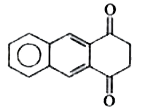 B
B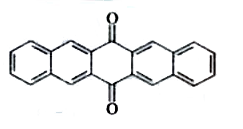 C
C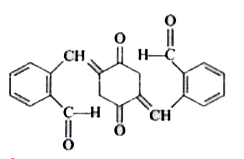 DNone of these
DNone of theseThe addition reaction of enol or enolate to the carbonyl function of aldehyde or ketone is known as aldol addition. The β- hydroxyaldehyde or β- hydroxyketone so obtained undergo dehydration in second steo to produce a conjugated enone. The first part of reaction is an addition reaction and the second part is an elimination reaction. Carbonyl compound having α- hydrogen undergoes aldol condensation reaction.
2CH3CH2−O∣∣C−HϴOH−−−−−→ΔCH3CH2CH=C∣CH3−O∣∣C−H
Mechanism:
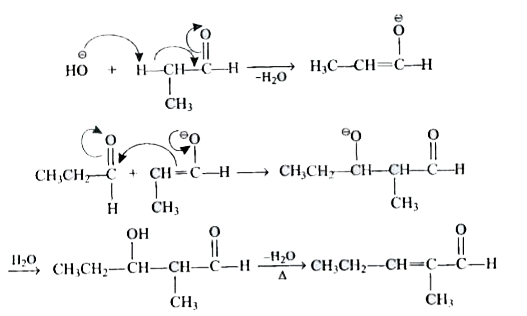
Whcih of the following will give aldol condensation?A BH−O∣∣C−HC
BH−O∣∣C−HC D
D
Which of the following reactions of glucose can be explained only by its cyclic structure?
(a)Glucose forms pentaacetate
(b)Glucose reacts with hydroxylamine to form an oxime
(c)Pentaacetate of glucose does not react with hydroxyl amine
(d)Glucose is oxidised by nitric acid to glyconic acid
View SolutionIntramolecular aldol condensation :
The aldol condensation also offer a convenient way to synthesize molecules with five and six membered ring.This can be done by an intramolecular aldol condensation using a dialdehyde, a keto aldehyde or a diketone as the substrate.The major product is formed by the attack of the enolate from the ketone side of the molecule that adds to the aldehyde group.The reason the aldehyde group undergoes addition preferentially may arise from the greater reactivity of aldehyde towards nucleophilic addition.In reaction of this type five membered rings from far more readily than seven membered rings and six membered rings are more favourable than four or eight membered rings when possible.
The true statement about the major product of CH3−O∣∣C−CH2−CH2−CH2−CH2−O∣∣C−H in reaction with aq.NaOH followed by heating is.
View Solution(a) Give a possible explaination for each one of the following : -
(i) There are two - NH2 groups in semicarbazide. However, only one such group is involvedin the formation of semicarbazones.
(ii) Cyclohexanone forms cyanohydrin in good yield but 2,4,6-trimethylcyclohexanone does not.
(b) An organic compound with molecular formulaC9H10O forms, 2,4- DNP derivative, reduces Tollens' reagent and undergoes Cannizzaro reaction.
On vigorous oxidation it gives 1,2-benzene-di-carboxylic acid. Identify the compound.
View SolutionWhen boromobenze is monochlorinated. Two isomeric compounds (A) and (B) are obtained. Monobromination of (A) gives several isomeric products of molecular formula C6H3ClBr2. While mononbromination of (B) yields only two isomers (C) and (D). Compound (C) is identiacla to one of the compounds obtained from the bromination of (A). However, (D) is totally different form any of the isomeric compounds obtained from the bromination of (A). Give the sturctures of (A),(B),(C) and (D), and also the structers of the four isomeric mononbrominated products of (A). Support your answer wtih resoning.
View SolutionWittig reaction :
The reaction of a phosphorus ylide with an aldehyde (or) ketone introduces a carbon-carbon double bond is place of the carbonyl bond.
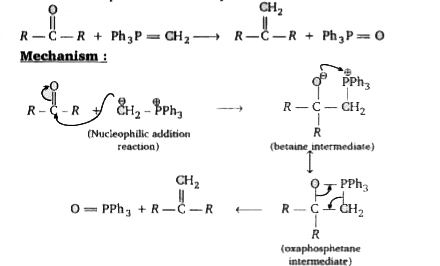
Driving froce of the reaction is high bond energy of (P = O). (ΔH=−ve).
CH3−O∣∣C−CH2−CH2−CH2−CH2−⊕PPh3Ph−Li−−−−→Δ(A), Major product (A) is :
View Solution
